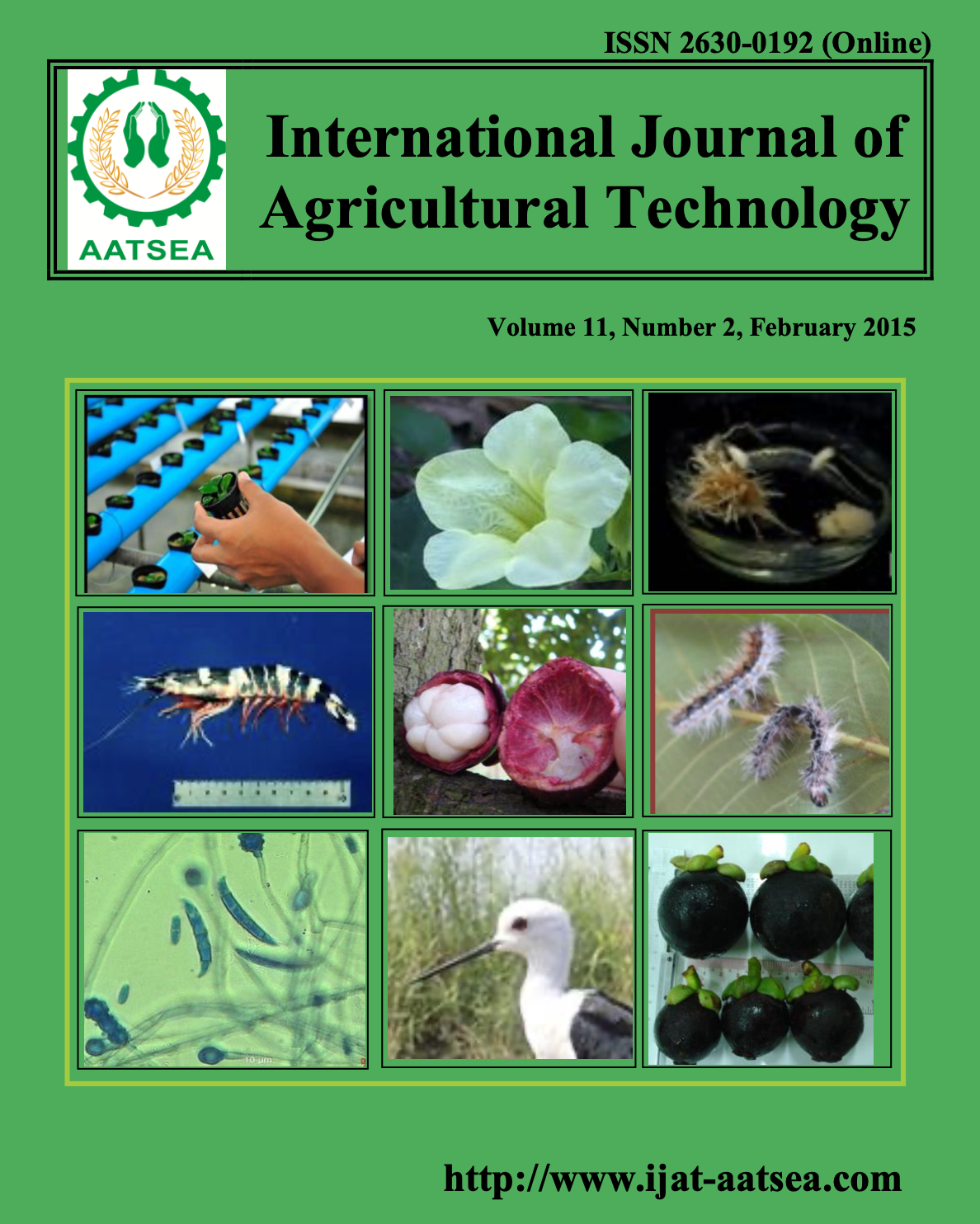Cytotoxicity and antimicrobial activities of leaf extracts from Barleria strigosa
Main Article Content
Abstract
Our preliminary phytochemical screening demonstrated that the methanolic extract from leaves of Barleria strigosa had in vitro cytotoxicity against the P-388 murine leukemia cell line with CC50 (50% cytotoxicity concentration) of 413.89 µg/ml and exhibited strong antibacterial activity against Bacillus subtilis with an inhibition zones of 14 mm at 10 mg/disc. Therefore, this present study attempts to evaluate the cytotoxicity and antimicrobial activity. The crude methanol extract was subjected to a liquid-liquid partition yielding hexane, dichloromethane, ethyl acetate and butanol extracts described by Beedessee et al. (2012). The cytotoxicity of all extracts were analyzed using MTT colorimetric assay described by Mosmann (1983) against six cancer cell lines (HepG-2, MCF-7, KB, HT-29, P388 and Hela cells) and two normal cell lines (Vero and L929 cells) at concentration range of 62.5 to 1000 µg/ml. By the MTT assay, the strongest cytotoxic activity was obtained from the butanol extract followed by the ethyl acetate, dichloromethane and hexane extract, respectively. Highest cytotoxicity of butanolic extract was found against P-388 cell line (CC50 = 127.42 µg/ml) and found cytotoxic against L-929, KB, Hela, MCF-7, HT-29, Vero and HepG-2 cells at the CC50 levels of 283.00, 287.22, 566.83, 574.19, 666.78, 835.92 and >1,000 µg/ml, respectively. The extracts were tested for their antimicrobial activity against five pathogenic bacteria (Bacillus subtilis, Escherichia coli, Micrococcus luteus, Pseudomonas aeruginosa and Staphyloccus aureus) at concentration range of 0.125 to 2 mg/disc using paper disc diffusion method described by Ansari et al. (2005). The butanol extract exhibited more interesting antimicrobial activity than other extracts, being especially active against M. luteus and S. aureus at 2 mg/disc with diameters of the inhibition zones was 8.8 and 8.22 mm, respectively. The results indicated that butanol extract exhibited cytotoxicity and antimicrobial activities. Therefore, the fractions from butanolic extract were also appreciating for further investigations in future.
Article Details

This work is licensed under a Creative Commons Attribution-NonCommercial-NoDerivatives 4.0 International License.
References
Amoo, S. O., Finnie, J. F. and Van Staden, J. (2009). In vitro pharmacological evaluation of three Barleria species. Journal of Ethnopharmacology. 121:274-277.
Amoo, S. O., Ndhlala, A. R., Finnie, J. F. and Van Staden, J. (2011). Antifungal, acetylcholinesterase inhibition, antioxidant and phytochemical properties of three Barleria species. South African Journal of Botany 77:435-445.
Amoo, S. O. and Van Staden, J. (2013). Pharmacological properties and in vitro shoot production of Barleria argillicola – A critically endangered South African species. South African Journal of Botany 85:87-93.
Aneja, K. R., Joshi, R. and Sharma, C. (2010). Potency of Barleria prionitis L. bark extracts against oral diseases causing strains of bacteria and fungi of clinical origin. New York Science Journal 3:5-12.
Ansari, M. A., Tirry, L. and Moens, M. (2005). Antagonism between entomopathogenic fungi and bacterial symbions of entomopathogenic nematodes. BioControl 50:465-475.
Ata, A., Kalhari, K. S. and Samarasekera, R. (2009). Chemical constituents of Barleria prionitis and their enzyme inhibitory and free radical scavenging activities. Phytochemistry Letters 2:37-40.
Beedessee, G., Ramanjooloo, A., Aubert, G. and Eloy, L. (2012). Cytotoxic activities of hexane, ethyl acetate and butanol extracts of marine sponges from Mauritian Waters on human cancer cell line. Environmental toxicology and pharmacology 34:397-408.
Chavan, C. B., Shinde, U. V., Hogade, M. and Bhinge, S. (2010). Screening of In-vitro antibacterial assay of Barleria proinitis LINN. Journal of Herbal Medicine and Toxicology 4:197-200.
Jaiswal, S.K., Dubey, M.K., Das, S., Verma, A. R., Vijayakumar, M. and Rao, C. V. (2010). Evaluation of flower of Barleria prioniris for anti-Inflammatory and anti nociceptive activity. International Journal of Pharma and Bio Sciences V 1:1-10.
Kumar, R. A., Sridevi, K. S., Kumar, N. V., Nanduri, S. and Rajagopal, S. (2004). Anticancer and immunostimulatory compounds from Andrographis paniculata. Journal of Ethnopharmacology 92:291-295
Manapradit, N., Poeaim, S. and Charoenying, P. (2013). Biological activity of crude extract of Barleria strigosa.
Mosmann, T. (1983). Rapid colorimetric assay for cellular growth and survival: Application toproliferation and cytotoxicity assays. Journal of Immunological Method 65:55-63.
Puttarak, P., Charoonratana, T. and Panichayupakaranant, P. (2010). Antimicrobial activity and stability of rhinacanthins-rich Rhinacanthus nasutus extract. Phytomedicine 17:323-327.
Salib, J. Y., Shafik, N. H., Michael, H. N. and Eskander, E. F. (2013). Antibacterial activity of Barleria cristata bark extracts. Journal of Applied Sciences Research 9:2156-2159.
Singh, R., Rajasree, P. H. and Sankar, C. (2012). Screening for anti-diabetic activity of the ethanolic extract of Barleria cristata seeds. International Journal of Pharmacy and Life Sciences 3:2044-2047.
Suba, V., Murugesan, T., Arunachalam, G., Mandal, S. C. and Saha, B. P. (2004). Anti-diabetic potential of Barleria lupulina extract in rats. Phytomedicine 11:202-205.
Tangpong, J. and Satarug, S. (2010). Alleviation of lead poisoning in the brain with aqueous leaf extract of the Thunbergia laurifolia (Linn.). Toxicology Letters 198:83-88.
Verma, P. K., Sharma, A., Joshi, S. C., Gupta, R. S. and Dixit, V. P. (2005). Effect of isolated fractions of Barleria prionitis root methanolic extract on reproductive function of male rats: preliminary study. Fitoterapia 76:428-432.


